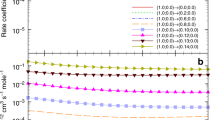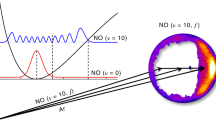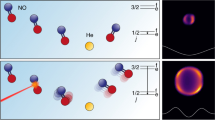Abstract
Vibrationally inelastic scattering is a fundamental collision process that converts some of the kinetic energy of the colliding partners into vibrational excitation1,2. The conventional wisdom is that collisions with high impact parameters (where the partners only ‘graze’ each other) are forward scattered and essentially elastic, whereas collisions with low impact parameters transfer a large amount of energy into vibrations and are mainly back scattered3. Here we report experimental observations of exactly the opposite behaviour for the simplest and most studied of all neutral–neutral collisions: we find that the inelastic scattering process H + D2(v = 0, j = 0, 2) → H + D2(v′ = 3, j′ = 0, 2, 4, 6, 8) leads dominantly to forward scattering (v and j respectively refer to the vibrational and rotational quantum numbers of the D2 molecule). Quasi-classical trajectory calculations show that the vibrational excitation is caused by extension, not compression, of the D–D bond through interaction with the passing H atom. However, the H–D interaction never becomes strong enough for capture of the H atom before it departs with diminished kinetic energy; that is, the inelastic scattering process is essentially a frustrated reaction in which the collision typically excites the outward-going half of the H–D–D symmetric stretch before the H–D2 complex dissociates. We suggest that this ‘tug of war’ between H and D2 is a new mechanism for vibrational excitation that should play a role in all neutral–neutral collisions where strong attraction can develop between the collision partners.
This is a preview of subscription content, access via your institution
Access options
Subscribe to this journal
Receive 51 print issues and online access
$199.00 per year
only $3.90 per issue
Buy this article
- Purchase on Springer Link
- Instant access to full article PDF
Prices may be subject to local taxes which are calculated during checkout



Similar content being viewed by others
References
Faubel, M. Vibrational and rotational excitation in molecular collisions. Adv. At. Mol. Phys. 19, 345–394 (1983)
Krajnovich, D. J., Parmenter, C. S. & Catlett, D. L. State-to-state vibrational transfer in atom-molecule collisions. Beams vs. bulbs. Chem. Rev. 87, 237–288 (1987)
Levine, R. D. Molecular Reaction Dynamics 376 (Cambridge Univ. Press, Cambridge, UK, 2005)
Miller, W. H. The semiclassical nature of atomic and molecular collisions. Acc. Chem. Res. 4, 161–167 (1971)
McBane, G. C., Kable, S. H., Houston, P. L. & Schatz, G. C. Collisional excitation of CO by 2.3 eV H atoms. J. Chem. Phys. 94, 1141–1149 (1991)
Kreutz, T. G. & Flynn, G. W. Analysis of translational, rotational, and vibrational energy transfer in collisions between CO2 and hot hydrogen atoms: The three-dimensional “breathing” ellipsoid model. J. Chem. Phys. 93, 452–465 (1990)
Wight, C. A., Donaldson, D. J. & Leone, S. R. A two-laser pulse-and-probe study of T-R, V energy transfer collisions of H + NO at 0.95 and 2.2 eV. J. Chem. Phys. 83, 660–667 (1985)
Rapp, D. & Kassal, T. The theory of vibrational energy transfer between simple molecules in nonreactive collisions. Chem. Rev. 69, 61–102 (1969)
Koszinowski, K., Goldberg, N. T., Pomerantz, A. E. & Zare, R. N. Construction and calibration of an instrument for three-dimensional ion imaging. J. Chem. Phys. 125, –133503 (2006)
Goldberg, N. T., Koszinowski, K., Pomerantz, A. E. & Zare, R. N. Doppler-free ion imaging of hydrogen molecules produced in bimolecular reactions. Chem. Phys. Lett. 433, 439–443 (2007)
Koszinowski, K. et al. Differential cross section for the H+D2→HD(v′ = 1, j′ = 2, 6, 10)+D reaction as a function of collision energy. J. Chem. Phys. 127, –124315 (2007)
Shafer, N. E., Orr-Ewing, A. J., Simpson, W. R., Xu, H. & Zare, R. N. State-to-state differential cross sections from photoinitiated bulb reactions. Chem. Phys. Lett. 212, 155–162 (1993)
Boothroyd, A. I., Keogh, W. J., Martin, P. G. & Peterson, M. R. A refined H3 potential energy surface. J. Chem. Phys. 104, 7139–7152 (1996)
Wrede, E. et al. The dynamics of the hydrogen exchange reaction at 2.20 eV collision energy: Comparison of experimental and theoretical differential cross sections. J. Chem. Phys. 110, 9971–9981 (1999)
Greaves, S. J., Murdock, D., Wrede, E. & Althorpe, S. C. New, unexpected, and dominant mechanisms in the hydrogen exchange reaction. J. Chem. Phys. 128, 164306 (2008)
Greaves, S. J., Murdock, D. & Wrede, E. A quasi-classical trajectory study of the time-delayed forward scattering in the hydrogen exchange reaction. J. Chem. Phys. 128, 164307 (2008)
Fernández-Alonso, F. et al. Evidence for scattering resonances in the H+D2 reaction. Angew. Chem. Int. Ed. 39, 2748–2752 (2000)
Allison, T. C., Friedman, R. S., Kaufman, D. J. & Truhlar, D. G. Analysis of the resonance in H+D2→HD(v′ = 3)+D. Chem. Phys. Lett. 327, 439–445 (2000)
Althorpe, S. C. et al. Observation and interpretation of a time-delayed mechanism in the hydrogen exchange reaction. Nature 416, 67–70 (2002)
Fernández-Alonso, F. & Zare, R. N. Scattering resonances in the simplest chemical reaction. Annu. Rev. Phys. Chem. 53, 67–99 (2002)
Ayers, J. D. et al. Measurement of the cross section for H+D2→HD(v′ = 3, j′ = 0)+D as a function of angle and energy. J. Chem. Phys. 119, 4662–4670 (2003)
Aoiz, F. J., Bañares, L. & Herrero, V. J. The H + H2 reactive system. Progress in the study of the dynamics of the simplest reaction. Int. Rev. Phys. Chem. 24, 119–190 (2005)
Monks, P. D. D., Connor, J. N. L. & Althorpe, S. C. Theory of time-dependent reactive scattering: Cumulative time-evolving differential cross sections and nearside-farside analyses of time-dependent scattering amplitudes for the H+D2→HD+D reaction. J. Phys. Chem. A 110, 741–748 (2006)
Monks, P. D. D., Connor, J. N. L. & Althorpe, S. C. Nearside-farside and local angular momentum analyses of time-independent scattering amplitudes for the H+D2(v i = 0, j i = 0)→HD(v f = 3, j f = 0)+D reaction. J. Phys. Chem. A 111, 10302–10312 (2007)
Goldberg, N. T., Zhang, J., Miller, D. J. & Zare, R. N. Corroboration of theory for H+D2→D+HD(v′ = 3,j′ = 0) reactive scattering dynamics. J. Phys. Chem. A 10.1021/jp801187p (in the press)
Giese, C. F. & Gentry, W. R. Classical trajectory treatment of inelastic scattering in collisions of H+ with H2, HD, and D2 . Phys. Rev. A 10, 2156–2173 (1974)
Hege, U. & Linder, F. Vibrationally inelastic scattering of H- ions from H2, N2, O2 and CO2 . Z. Phys. A 320, 95–104 (1985)
Osborn, M. K. & Smith, I. W. M. A quasiclassical trajectory study of vibrational energy transfer in collisions involving intermolecular attraction of moderate strength. Chem. Phys. 91, 13–26 (1984)
Acknowledgements
The Stanford team gratefully acknowledges support by the US National Science Foundation under grant NSF CHE 0650414. S.J.G. is supported by the EPSRC LASER Portfolio Partnership grant GR/S71750/01.
Author Contributions N.T.G. designed and performed the experiments with the help of J.Z. and D.J.M., analysed the experimental data, and assisted with the manuscript. S.J.G and E.W. performed quasi-classical trajectory calculations, formulated the mechanism, and prepared figures and movies. R.N.Z. wrote the manuscript. All authors discussed the results and commented on the manuscript.
Author information
Authors and Affiliations
Corresponding author
Supplementary information
Supplementary information
The file contains Supplementary Figures 1-7 with Legends. The file includes an overview of the QCT method and the BKMP2 PES, followed by impact-parameter/deflection-angle correlation diagrams indicating those trajectories for which movies are made available in the Supplementary Information. Measured DCSs for the complementary reactive HD(v?=3, j?=0) channel are compared with fully QM calculations. (PDF 631 kb)
Supplementary information
The file contains Supplementary Videos 1-6. The file includes QCT movies for six representative trajectories leading to D2(v?=3, j?=0) products. In each case the D-D bond is not compressed by the incoming H atom; instead, it is extended. In some cases it is pulled out whereas in others it is stabilized at the turning point. (PPT 4558 kb)
Supplementary information
The file contains Supplementary Videos 7-10. The file includes QCT movies for four representative trajectories leading to D2(v?=3, j?=4) products. The same mechanism is operative for this product state: the D-D bond is not compressed by the incoming H atom; instead it is extended. In some cases it is pulled out whereas in others it is stabilized at the turning point. (PPT 4570 kb)
Rights and permissions
About this article
Cite this article
Greaves, S., Wrede, E., Goldberg, N. et al. Vibrational excitation through tug-of-war inelastic collisions. Nature 454, 88–91 (2008). https://doi.org/10.1038/nature07079
Received:
Accepted:
Issue Date:
DOI: https://doi.org/10.1038/nature07079
This article is cited by
-
Single solvent molecules can affect the dynamics of substitution reactions
Nature Chemistry (2012)
-
Taking Ockham's razor to enzyme dynamics and catalysis
Nature Chemistry (2012)
-
Enzyme dynamics and catalysis in the mechanism of DNA polymerase
Theoretical Chemistry Accounts (2012)
-
When molecules don't rebound
Nature (2008)
Comments
By submitting a comment you agree to abide by our Terms and Community Guidelines. If you find something abusive or that does not comply with our terms or guidelines please flag it as inappropriate.



